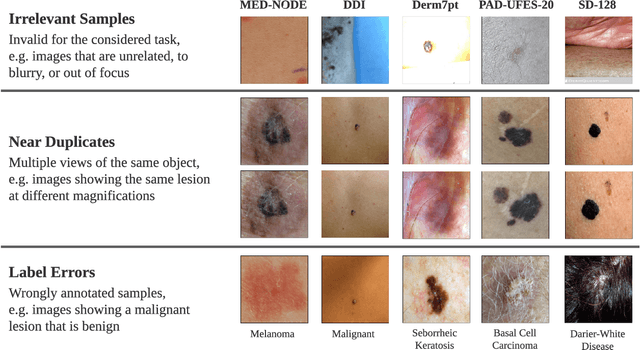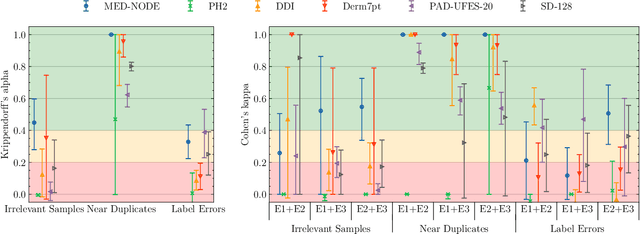Alvaro Gonzalez-Jimenez
Towards Scalable Foundation Models for Digital Dermatology
Nov 08, 2024Abstract:The growing demand for accurate and equitable AI models in digital dermatology faces a significant challenge: the lack of diverse, high-quality labeled data. In this work, we investigate the potential of domain-specific foundation models for dermatology in addressing this challenge. We utilize self-supervised learning (SSL) techniques to pre-train models on a dataset of over 240,000 dermatological images from public and private collections. Our study considers several SSL methods and compares the resulting foundation models against domain-agnostic models like those pre-trained on ImageNet and state-of-the-art models such as MONET across 12 downstream tasks. Unlike previous research, we emphasize the development of smaller models that are more suitable for resource-limited clinical settings, facilitating easier adaptation to a broad range of use cases. Results show that models pre-trained in this work not only outperform general-purpose models but also approach the performance of models 50 times larger on clinically relevant diagnostic tasks. To promote further research in this direction, we publicly release both the training code and the foundation models, which can benefit clinicians in dermatological applications.
PASSION for Dermatology: Bridging the Diversity Gap with Pigmented Skin Images from Sub-Saharan Africa
Nov 07, 2024Abstract:Africa faces a huge shortage of dermatologists, with less than one per million people. This is in stark contrast to the high demand for dermatologic care, with 80% of the paediatric population suffering from largely untreated skin conditions. The integration of AI into healthcare sparks significant hope for treatment accessibility, especially through the development of AI-supported teledermatology. Current AI models are predominantly trained on white-skinned patients and do not generalize well enough to pigmented patients. The PASSION project aims to address this issue by collecting images of skin diseases in Sub-Saharan countries with the aim of open-sourcing this data. This dataset is the first of its kind, consisting of 1,653 patients for a total of 4,901 images. The images are representative of telemedicine settings and encompass the most common paediatric conditions: eczema, fungals, scabies, and impetigo. We also provide a baseline machine learning model trained on the dataset and a detailed performance analysis for the subpopulations represented in the dataset. The project website can be found at https://passionderm.github.io/.
* MICCAI 2024
Hyperbolic Metric Learning for Visual Outlier Detection
Mar 22, 2024



Abstract:Out-Of-Distribution (OOD) detection is critical to deploy deep learning models in safety-critical applications. However, the inherent hierarchical concept structure of visual data, which is instrumental to OOD detection, is often poorly captured by conventional methods based on Euclidean geometry. This work proposes a metric framework that leverages the strengths of Hyperbolic geometry for OOD detection. Inspired by previous works that refine the decision boundary for OOD data with synthetic outliers, we extend this method to Hyperbolic space. Interestingly, we find that synthetic outliers do not benefit OOD detection in Hyperbolic space as they do in Euclidean space. Furthermore we explore the relationship between OOD detection performance and Hyperbolic embedding dimension, addressing practical concerns in resource-constrained environments. Extensive experiments show that our framework improves the FPR95 for OOD detection from 22\% to 15\% and from 49% to 28% on CIFAR-10 and CIFAR-100 respectively compared to Euclidean methods.
Towards Reliable Dermatology Evaluation Benchmarks
Sep 13, 2023



Abstract:Benchmark datasets for digital dermatology unwittingly contain inaccuracies that reduce trust in model performance estimates. We propose a resource-efficient data cleaning protocol to identify issues that escaped previous curation. The protocol leverages an existing algorithmic cleaning strategy and is followed by a confirmation process terminated by an intuitive stopping criterion. Based on confirmation by multiple dermatologists, we remove irrelevant samples and near duplicates and estimate the percentage of label errors in six dermatology image datasets for model evaluation promoted by the International Skin Imaging Collaboration. Along with this paper, we publish revised file lists for each dataset which should be used for model evaluation. Our work paves the way for more trustworthy performance assessment in digital dermatology.
Robust T-Loss for Medical Image Segmentation
Jun 01, 2023Abstract:This paper presents a new robust loss function, the T-Loss, for medical image segmentation. The proposed loss is based on the negative log-likelihood of the Student-t distribution and can effectively handle outliers in the data by controlling its sensitivity with a single parameter. This parameter is updated during the backpropagation process, eliminating the need for additional computation or prior information about the level and spread of noisy labels. Our experiments show that the T-Loss outperforms traditional loss functions in terms of dice scores on two public medical datasets for skin lesion and lung segmentation. We also demonstrate the ability of T-Loss to handle different types of simulated label noise, resembling human error. Our results provide strong evidence that the T-Loss is a promising alternative for medical image segmentation where high levels of noise or outliers in the dataset are a typical phenomenon in practice. The project website can be found at https://robust-tloss.github.io
SelfClean: A Self-Supervised Data Cleaning Strategy
May 26, 2023



Abstract:Most commonly used benchmark datasets for computer vision contain irrelevant images, near duplicates, and label errors. Consequently, model performance on these benchmarks may not be an accurate estimate of generalization ability. This is a particularly acute concern in computer vision for medicine where datasets are typically small, stakes are high, and annotation processes are expensive and error-prone. In this paper, we propose SelfClean, a general procedure to clean up image datasets exploiting a latent space learned with self-supervision. By relying on self-supervised learning, our approach focuses on intrinsic properties of the data and avoids annotation biases. We formulate dataset cleaning as either a set of ranking problems, where human experts can make decisions with significantly reduced effort, or a set of scoring problems, where decisions can be fully automated based on score distributions. We compare SelfClean against other algorithms on common computer vision benchmarks enhanced with synthetic noise and demonstrate state-of-the-art performance on detecting irrelevant images, near duplicates, and label errors. In addition, we apply our method to multiple image datasets and confirm an improvement in evaluation reliability.
 Add to Chrome
Add to Chrome Add to Firefox
Add to Firefox Add to Edge
Add to Edge